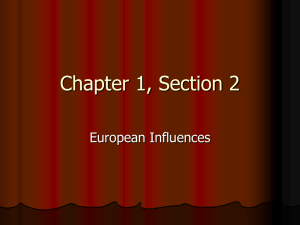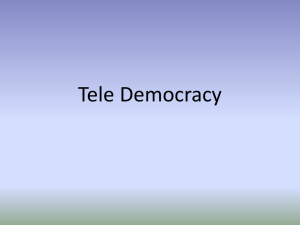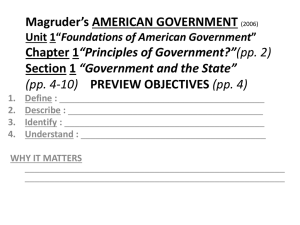Government in America
advertisement
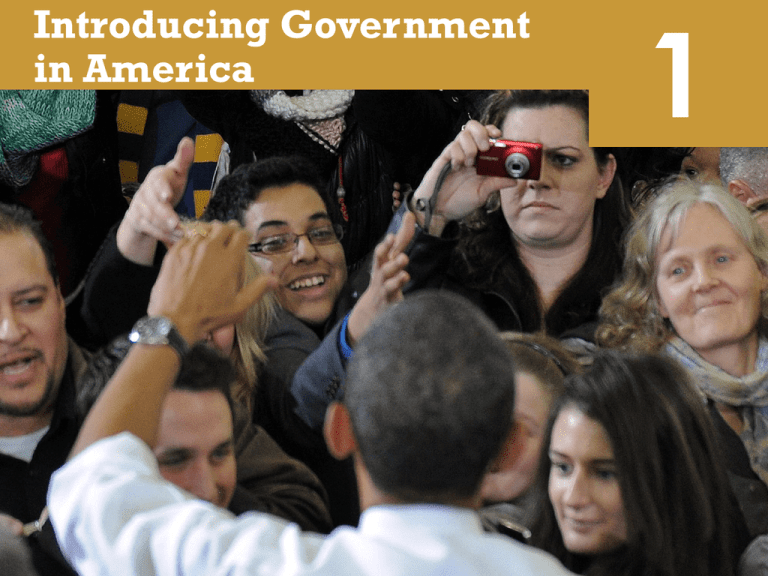
Introducing Government in America 1 Video: The Big Picture 1 http://media.pearsoncmg.com/ph/hss/SSA_SHARED_MED IA_1/polisci/presidency/Edwards_Ch01_Introducing_Gover nment_in_America_Seg1_v2.html Learning Objectives 1.1 1.2 Identify the key functions of government and explain why they matter Define politics in the context of democratic government 1 Learning Objectives 1.3 1.4 1 Assess how citizens can have an impact on public policy and how policies can impact people Identify the key principles of democracy and outline theories regarding how it works in practice and the challenges democracy faces today Learning Objectives 1.5 1 Outline the central arguments of the debate in America over the proper scope of government Video: The Basics 1 http://media.pearsoncmg.com/ph/hss/SSA_SHARED_MED IA_1/polisci/presidency/Seg2_IntroAmrGov_v2.html Government What is government? How should we govern? What should government do? Maintain a national defence Provide public goods and services Preserve order Socialize the young Collect taxes 1.1 Transfer of Power 1.1 Afghanistan 1.1 1.1 Which of the following is not a duty of government? a. Collecting taxes b. Proving for national defense c. Promoting religion d. Preserving order 1.1 1.1 Which of the following is not a duty of government? a. Collecting taxes b. Proving for national defense c. Promoting religion d. Preserving order 1.1 Politics What is politics? Who gets what, when, and how Political participation More than just voting 1.2 FIGURE 1.1: Political apathy among young and old Americans, 1972–2008 1.2 FIGURE 1.2: Age and political knowledge, 1972 and 2008 1.2 Video Time… Jimmy Kimmel - ObamaCare FIGURE 1.3: Election turnout rates of young and old Americans, 1972–2010 1.2 Politics Single-issue groups e.g., abortion 1.2 Abortion rally 1.2 1.2 Which is true of single-issue groups? a. They increase voter participation. b. They negatively affect voter turnout. c. They vote just for politicians who support their issue. d. They force politicians to consider compromises. 1.2 1.2 Which is true of single-issue groups? a. They increase voter participation. b. They negatively affect voter turnout. c. They vote just for politicians who support their issue. d. They force politicians to consider compromises. 1.2 Policymaking System People Shape Policy Politics Impact People 1.3 FIGURE 1.4: The policymaking system 1.3 People Shape Policy Linkage institutions Policy agenda Political issue Policymaking institutions Congress Presidency Courts 1.3 Politics Impact People Public policy Statute Presidential action Court decision Budgetary choice Regulation Policies should be effective Policies must have a goal 1.3 Table 1.1: Types of public policies 1.3 1.3 Which of the following is an example of public policy? a. Personal conviction b. Parental rule c. Congressional statute d. Religious edict 1.3 1.3 Which of the following is an example of public policy? a. Personal conviction b. Parental rule c. Congressional statute d. Religious edict 1.3 Democracy in America 1.4 Traditional Democratic Theory Three Contemporary Theories of American Democracy Challenges to Democracy American Political Culture and Democracy A Culture War Traditional Democratic Theory Key principles of the democratic process (according to Dahl): Equality in voting Effective participation Enlightened understanding Citizen control of the agenda Inclusion Majority rule and minority rights Representation 1.4 Three Contemporary Theories of American Democracy Pluralism Groups of minorities working together Elitism Power is held by the wealthy Hyperpluralism Too many groups try to control policy 1.4 Elitism? Time to Draw… Take a piece of paper. Design a bar graph or line graph of the current distribution of wealth in America. Go from 0% to 100% in 10% increments. Now we will compare our graphs to how wealth is truly shared in America. Did we get close? Video Time. Challenges to Democracy Increased complexity of issues Limited participation in government Diverse political interests Policy gridlock Escalating campaign costs 1.4 Super PAC contributions 1.4 Video Time… Citizens United v FEC And Someone’s Reaction to it… American Political Culture and Democracy 1.4 Political culture based on American creed Liberty Egalitarianism Individualism Laissez-faire Populism New Hampshire license plate 1.4 American Political Culture and Democracy 1.4 Political culture based on American creed Liberty Egalitarianism Individualism Laissez-faire Populism FIGURE 1.5: Pride in equal treatment of groups in the U.S. and other established democracies 1.4 American Political Culture and Democracy 1.4 Political culture based on American creed Liberty Egalitarianism Individualism Laissez-faire Populism A Culture War? Polarization of liberal and conservative political culture Is it happening? Testing a crisis of values Loss of traditional values Less patriotism Irreconcilable differences 1.4 Video: In Context 1 http://media.pearsoncmg.com/ph/hss/SSA_SHARED_MED IA_1/polisci/presidency/Seg3_PoliticalCulture_v2.html 1.4 Which of the following illustrates hyperpluralism? a. Use of the court system to try to set policy b. Decrease in patriotism c. Reliance on Congress to limit special interests d. Diversity in political interests 1.4 1.4 Which of the following illustrates hyperpluralism? a. Use of the court system to try to set policy b. Decrease in patriotism c. Reliance on Congress to limit special interests d. Diversity in political interests 1.4 Scope of Government in America How Active Is American Government? 1.5 Video: Thinking Like a Political Scientist 1 http://media.pearsoncmg.com/ph/hss/SSA_SHARED_MED IA_1/polisci/presidency/Seg4_Intro_v2.html 1.5 How Active Is American Government? Gross domestic product (GDP) Government spends 1/3 Government employs 24 million people Americans expect government to solve problems Unemployment, terrorism, illegal immigration, energy, education, lack of access to health care 1.5 Video: In the Real World 1 http://media.pearsoncmg.com/ph/hss/SSA_SHARED_MED IA_1/polisci/presidency/Seg5_IntroAmrGov_v2.html 1.5 About one-third of the GDP is spent by a. The federal government b. State governments c. Local governments d. All three governments combined 1.5 1.5 About one-third of the GDP is spent by a. The federal government b. State governments c. Local governments d. All three governments combined 1.5 Discussion Question What are the three theories of policymaking in the United States? Which theory seems most plausible to you? Why? 1 Video: So What? 1 http://media.pearsoncmg.com/ph/hss/SSA_SHARED_MEDIA _1/polisci/presidency/Edwards_Ch01_Introducing_Governme nt_in_America_Seg6_v2.html
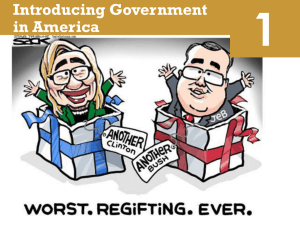
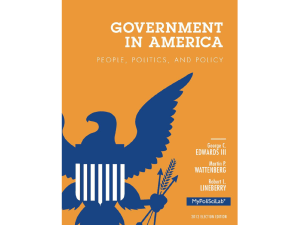
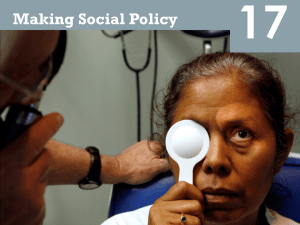
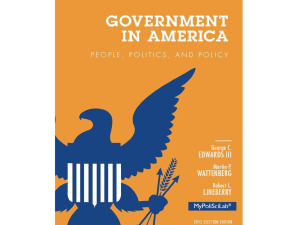
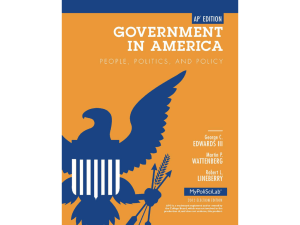

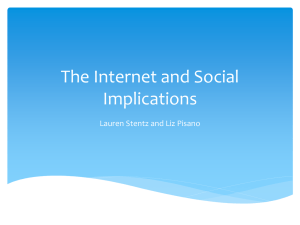
![“The Progress of invention is really a threat [to monarchy]. Whenever](http://s2.studylib.net/store/data/005328855_1-dcf2226918c1b7efad661cb19485529d-300x300.png)

